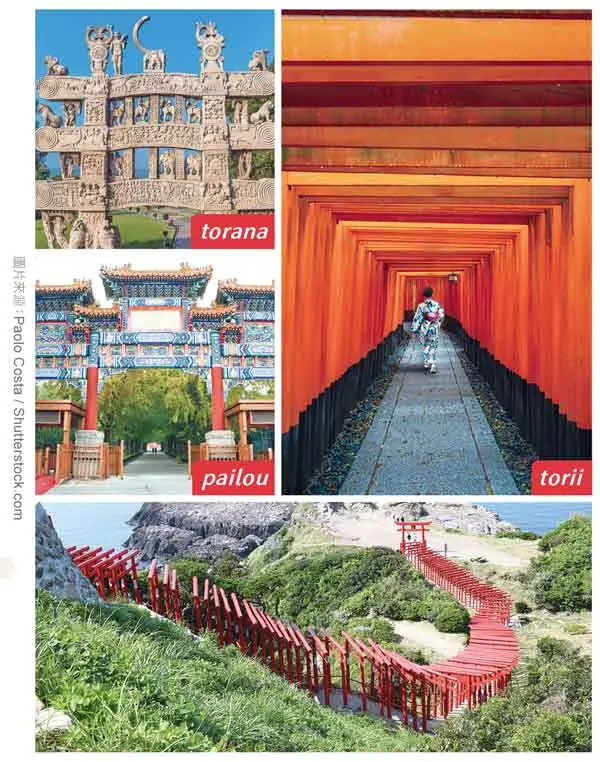
鸟居代表了人界和神域之间的边界。当一个人穿越一 道鸟居,他就进入了神圣的土地。
作者 Derek Davies
本图文出处
https://www.ivy.com.tw/newsLetter/an...062413561374377MP3
https://www.dropbox.com/s/1e87...MP3.rar?dl=0目录 / Tips & Analysis / 中文翻译(& 答案)
文意选填
The torii of Japan is one of the many symbols of the country. These simple yet mystifying gates dot the Japanese __1__. But where exactly do they come from, and what do they represent?
While the origins of these aesthetic-looking gates are not clear, many historians believe that they have been __2__ from India or China. In India, gates called torana appear at entrances to Buddhist and Hindu temples. The name torana also sounds a bit similar to torii, which further __3__ the theory. In China, similar structures known as pailou are built at the entrances to Buddhist and Taoist temples as well. Japanese legend, however, says differently.

According to the Kojiki, a collection of myths written in 712 about Japan and its local deities or kami, the origin of torii has to do with Amaterasu, the sun goddess of the Shinto religion. She became outraged by her __4__ brother’s destructive behavior. She then locked herself in a cave, plunging the world into __5__. Other kami thought of a way to entice her to come out: to get the bird of the morning to call out. They __6__ a perch in front of the cave and positioned roosters on it. This perch was the first torii. Upon hearing the roosters call, Amaterasu emerged to see what was going on, returning light to the world. The story sounds __7__ since the Japanese characters for torii literally mean “bird home.”
The torii __8__ the border between the living world and the spirit world. When one crosses through a torii, they are entering __9__ land, the land of the kami. Each torii that a person passes through means they are entering a land holier than the last. When leaving a temple, it’s important to leave through all of the gates you walked through when entering; otherwise, you’ll be __10__ in the spirit world. So, the next time you’re admiring a temple in Japan, remember to be respectful towards the kami and return to our world safe and sound.
(A) stuck (B) wicked (C) adds to (D) installed (E) darkness
(F) imported (G) landscape (H) sacred ( I ) reasonable (J) stands for
答案:1.G 2.F 3.C 4.B 5.E 6.D 7.I 8.J 9.H 10.A
单字片语整理
Words in Use
●
theory [ˋθiərɪ]
n. 学说;理论
●
sacred [ˋsekrɪd]
a. 神圣的
●
myth [mɪθ]
n. 神话;迷思,错误的想法
●
destructive [dɪˋstrʌktɪv]
a. 破坏的
●
plunge [plʌndʒ]
n. & vi. 跳入
vi. 骤降
●
spiritual [ˋspɪrɪtʃʊəl]
a. 精神上的,心灵上的
●
install [ɪnˋstɔl]
.vt. 装设,安装;使就任(此意多用被动语态)
●
legend [ˋlɛdʒənd]
n. 传说
●
landscape [ˋlænd͵skep]
n. 景色(可数)
vt. 美化……的景观
●
respectful [rɪˋspɛktfəl]
a. 值得尊敬的;体面的,相当不错的
●
emerge [ɪˋmɝdʒ]
vi. 出现,冒出(常与介词 from 并用)
●
stuck [stʌk]
stick的动词过去式、过去分词
●
wicked [ˋwɪkɪd]
a. 恶毒的;缺德的
●
reasonable [ˋriznəb!]
a. 合理的;讲理的
●
perch [pɝtʃ]
vi. 栖息 / 停留于
n. 鸟类的栖
●
literally [ˋlɪtərəlɪ]
adv. . 照字面地,直译地;真正 / 确实地
●
aesthetic [ɛsˋθɛtɪk]
a. . 美(感)的,审美的〔英〕(= esthetic [ Es`HEtIk ]〔美〕)
●
outrage [ˋaʊt͵redʒ]
vt. . 使愤慨
n. 令人愤慨的事
●
holy [ˋholɪ]
a. 神圣的
●
darkness [ˋdɑrknɪs]
n. 黑暗
●
import [ˋɪmport]
n. 进口品
●
mystifying [ `mɪsəˌfɑɪɪɧ ]
a. 神秘的,令人困惑的
●
deity [ˋdiətɪ]
n. 神祇
●
Shinto [ˋʃɪnto]
n. (日本)神道教
●
entice [ɪnˋtaɪs]
vt. 引诱,诱使
Practical Phrases
●
safe and sound 安然无恙地
I felt happy to learn that Ben had come back safe and sound.
知道班已经安然无恙地回来,我感到很高兴。
●
stand for... 代表 / 象征......
To most people, roses stand for love.
对大部分的人来说,玫瑰花象征爱情。
●
add to sth 增添某事物
The fancy dress added to Wendy's charm.
这件漂亮的洋装增添了温蒂的魅力。
●
have to do with... 与⋯⋯有关
●
call out 大声喊叫
Seeing the man trapped under a car, Katy called out for help.
看到男子被困在车底,凯蒂大声呼叫救援。
Tips & Analysis
1. These simple yet mystifying gates dot the Japanese landscape.
理由
a. 空格前有定冠词 the 和形容词 Japanese(日本的),故知空格应置入名词以被 Japanese 修饰。
b. 选项中有 (E) darkness 及 (G) landscape 符合条 件,空格前提及鸟居是日本的代表标志之一,可猜 测鸟居在日本很常见,也就是说,日本「地景」上 星罗棋布着这些简单却神秘的门,故选 (G)。
2. While the origins of these aesthetic-looking gates are not clear, many historians believe that they have been imported from India or China.
理由
a. 空格前有 be 动词 been,而空格后有介词 from, 故知空格应置入分词、形容词或名词。
b. 剩余选项中除 (C) adds to 及 (J) stands for 外皆 符合条件,空格后说明鸟居和印度、中国的建物有 相似之处,可知鸟居可能是从印度或中国「传入」 的,故答案应选 (F) imported。
3. The name torana also sounds a bit similar to torii, which further adds to the theory.
理由
a. 空格位于关系代名词 中,修饰前半子句。空格前有副词 further(进一 步),后有名词词组 the theory(该理论),且根 据本句时态,可知空格应置入现在式第三人称单数 及物(片语)动词。
b. 选项中有 (C) adds to 及 (J) stands for 符合条 件,本句前半提及印度的托拉纳听起来跟鸟居的日 文(torii)有点类似,可知这进一步「增加」了鸟 居是由印度传入这个理论的说服力,故选 (C)。
4. She became outraged by her wicked brother’s destructive behavior.
理由
a. 空格前有所有格 her,空格后有名词词组 brother’s destructivebehavior(弟弟的破坏行为),故知 空格应置入形容词或分词以修饰该名词词组。
b. 剩余选项中除 (E) darkness 及 (J) stands for 外 皆符合条件,根据语意,天照大神对「邪恶」弟弟 的破坏行为感到愤怒,可知答案应选(B) wicked。
5. She then locked herself in a cave, plunging the world into darkness.
理由
a. 空格前有介词 into,故知空格应置入名词。
b. 选项中仅剩 (E) darkness 符合条件,置入后表 后来天照大神把自己关在洞穴之中,使得世界陷 入「黑暗」,因天照大神是太阳神,若无天照大神世界就会一片黑暗,符合语意,故选之。
6. They installed a perch in front of the cave and positioned roosters on it.
理由
a. 空格前有代名词 They,而空格后有名词词组 a perch(栖木),且根据对等连接词 and 后面的过 去式动词 positioned(放置),可知空格应置入过 去式及物(片语)动词。
b. 选项中尚有 (A) stuck 及 (D) installed 符合条件, 根据语意,其他神明在洞穴前「安装」了一个栖 木,并将公鸡放在上头,可知答案应选 (D)。
7. The story sounds reasonable since the Japanese characters for torii literally mean “bird home.”
理由
a. 空格前有感官动词 sounds(听起来),可知空格 应置入形容词或分词以作主词 The story(这个故 事)的补语。
b. 剩余选项中除 (J) stands for 外皆符合条件,本句 后半提及鸟居的日文字面上意思即是「鸟之家」, 可知因为这样,其他神明用公鸡引诱天照大神现身 的故事很「合理」,故选 (I) reasonable。
8. The torii stands for the border between the living world and the spirit world.
理由
a. 空格前有名词词组Thetorii(鸟居),而空格后亦 有一名词词组 the border(边界),且根据本段时 态,可知空格应置入现在式第三人称单数及物(片 语)动词。
b. 选项中仅剩 (J) stands for 符合条件,置入后表鸟 居「代表了」人界和神域之间的边界,故选之。
9. When one crosses through a torii, they are entering sacred land, the land of the kami.
理由
a. 空格前有 be 动词 are 和现在分词 entering(进 入),空格后有名词 land(土地),故知空格应置 入形容词或分词以修饰 land。
b. 剩余选项皆符合条件,本句后半有同位语 the land of the kami(神祇的领域),可知穿越鸟居就进入 了「神圣的」土地,故选 (H) sacred。
10. When leaving a temple, it’s important to leave through all of the gates you walked through when entering; otherwise, you’ll be stuck in the spirit world.
理由
a. 空格前有原形 be 动词,而空格后有介词 in,故知 空格应置入形容词、分词或名词。
b. 选项中仅剩 (A) stuck 符合条件,置入后表离开寺 院时要走过进寺院时穿过的每道鸟居;否则,你会 被「困在」神域中,符合语意,故选之。
中文翻译(& 答案)
日本鸟居 | 通往神域的入口
日本的鸟居是该国的众多代表标志之一。日本地景上星 罗棋布着这些简单却神秘的门。但它们究竟源自何方,它们 又代表了什么?
虽然这些外观精美的门之起源尚不明,但许多历史学家 认为它们是从印度或中国传入的。在印度,称为托拉纳的门 出现在佛教和印度教寺院的入口处。托拉纳这个名字听起来 也跟鸟居的日文发音(torii)有点类似,这进一步增加了该 理论的说服力。在中国,被称为牌楼的类似建物也设于佛寺 和道观的进门处。然而,日本的传说却有不同的说法。
根据《古事记》─ 写于 712 年,有关日本与当地神 祇(神祇日语念作 kami)的一本神话集 ─ 鸟居的起源与 天照大神有关,其为神道教的太阳女神。祂对自己邪恶弟弟 的破坏行为感到愤怒。后来祂把自己关在洞穴之中,使得世 界陷入黑暗。其他神明想了个办法引诱祂出来:让司晨之鸟 大声呼叫。祂们在洞穴前安装了一个栖木,并将公鸡放在上 头。这个栖木便是最初的鸟居。一听到公鸡的叫声,天照大 神便现身出来看看发生了什么事,这让世界重返光明。这个 故事听起来很合理,因为鸟居的日文字面上意思即是「鸟之 家」。
鸟居代表了人界和神域之间的边界。当一个人穿越一 道鸟居,他就进入了神圣的土地 ─ 神祇的领域。一个人 经过的每一道鸟居意味着他正踏上比前一处更神圣的土地。 离开寺院时,很重要的一点是要走过进寺院时穿过的每道 鸟居;否则,你会被困在神域中。因此,下次你在日本观赏 寺院时,记得对神明保持敬重,并平平安安地回到我们的世界。










